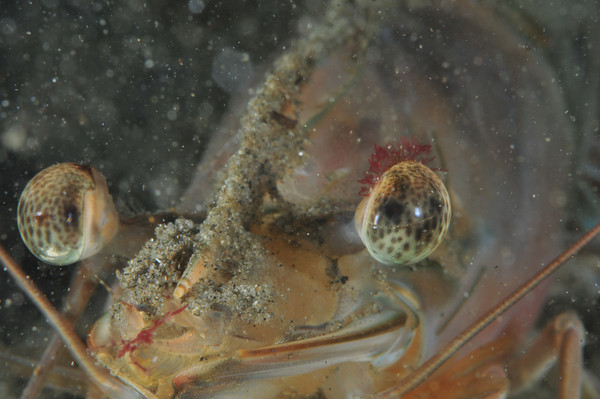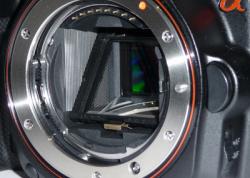Backscatter Underwater
Bluewater Photo is a leading retailer of underwater photography equipment and stocks housings, cameras, lights and accessories from the major brands. They also provide 5-star customer service and free US shipping on all orders over $200.
The underwater photographer constantly has to worry about avoiding backscatter when using strobes, or especially when using an internal flash. Backscatter presents many challenges. Backscatter is mainly caused by strobes or the internal flash lighting up particles in the water in between the lens and the subject. It can also be caused by lighting up open water directly behind a subject. Backscatter is easier to see against a dark background.

This photo suffers from the dreaded "Backscatter" - which ruined a nice photo! Brown shrimp from Redondo Beach, Southern Califorina.
Strobe position to reduce backscatter
If you are a beginner in underwater photography, you may want to watch my video tutorial on reducing backscatter.
The most backscatter can be seen when a strobe is positioned right next to the lens, for example like the internal flash of a point and shoot camera. The backscatter will be worse when the subject is far away, or if the water is filled with plankton or sand. Shooting into open water also shows more backscatter than if a subject has reef directly behind it.
To reduce backscatter, photographers will use two strobes far from the lens, that light up the subject with only the edge of the light beams. A diagram showing this is also on the strobe diagram page.

This is the strobe position I would use for a fish 2-3ft in front of the camera, to reduce backscatter. Notice how the strobes are out wider and pointing out slightly. For a macro subject very close to the lens, I would pull the strobes in just enough so the edges of the cone touch the subject, but the strobes would still be pointing out slightly.
Backscatter from yourself and your buddies:
In sandy and silty environments, the cause of backscatter is often your own fins, or your buddy’s fins. The following will help:
Make sure you and your buddies have good buoyancy, and frog kick around photo subjects instead of flutter kicking
Stay downcurrent of the photo subject
Discuss the concept of personal space with your diving buddies. Make sure they wait for their turn to shoot a few feet away, downcurrent of the photo subject.
Dive with others who have mastered frog-kicking
If a current is pushing you towards your dive buddy, use a Lembeh stick to avoid having to fin to change course. This can greatly reduce backscatter and underwater collisions
Preventing backscatter in a compact camera
In a compact camera, you are often using the internal flash. Use the diffuser to reduce backscatter in your photos slightly. The best solution is to get an external strobe. Make sure you completely block your internal flash after getting your external strobe, otherwise there will still be backscatter from the internal flash. Duct tape on the outside of the housing works well.
Top tips to prevent backscatter
If you have external strobes, use proper strobe position. Bring your strobes out wide, away from the port, and don't point them towards the subject, just light the subject with the edge of the cone.
Take photos far away from other people
Use proper fins, learn frog-kicking technique, acheive perfect buoyancy
Only take photos within a few inches of your port, either in macro mode, with a macro lens or with a fisheye lens.
Find areas of the dive site with better visibility, which is often right near the surface, down deeper, or in a protected area of the reef
Dont' shoot against the open water, shoot at a subject with reef directly behind it. This can be very effective.
Strobe aiming lights
Some strobes come with built in focus lights, or aiming lights. I almost never have those pointed directly at my subject, unless I'm shooting supermacro, or I'm shooting in very clear water, or I need to light up a subject in a cave and my focus light isn't doing the job.
Removing backscatter in Photoshop
You can read about editing underwater photos using Photoshop.
Further Reading

RECOMMENDED ARTICLES
SUPPORT THE UNDERWATER PHOTOGRAPHY GUIDE:
The Best Service & Prices on u/w Photo Gear
 Visit Bluewater Photo & Video for all your underwater photography and video gear. Click, or call the team at (310) 633-5052 for expert advice!
Visit Bluewater Photo & Video for all your underwater photography and video gear. Click, or call the team at (310) 633-5052 for expert advice!
The Best Pricing, Service & Expert Advice to Book your Dive Trips
 Bluewater Travel is your full-service scuba travel agency. Let our expert advisers plan and book your next dive vacation. Run by divers, for divers.
Bluewater Travel is your full-service scuba travel agency. Let our expert advisers plan and book your next dive vacation. Run by divers, for divers.





























